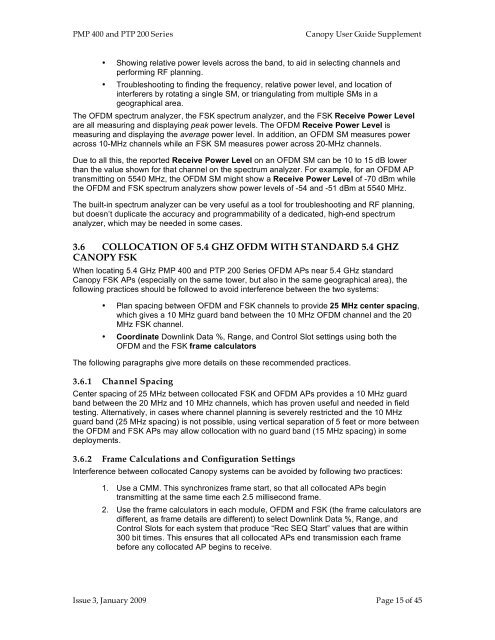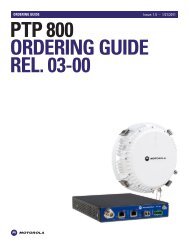Supplement to the Canopy System Release 8 User Guide PMP 400
Supplement to the Canopy System Release 8 User Guide PMP 400
Supplement to the Canopy System Release 8 User Guide PMP 400
Create successful ePaper yourself
Turn your PDF publications into a flip-book with our unique Google optimized e-Paper software.
<strong>PMP</strong> <strong>400</strong> and PTP 200 Series<strong>Canopy</strong> <strong>User</strong> <strong>Guide</strong> <strong>Supplement</strong>• Showing relative power levels across <strong>the</strong> band, <strong>to</strong> aid in selecting channels andperforming RF planning.• Troubleshooting <strong>to</strong> finding <strong>the</strong> frequency, relative power level, and location ofinterferers by rotating a single SM, or triangulating from multiple SMs in ageographical area.The OFDM spectrum analyzer, <strong>the</strong> FSK spectrum analyzer, and <strong>the</strong> FSK Receive Power Levelare all measuring and displaying peak power levels. The OFDM Receive Power Level ismeasuring and displaying <strong>the</strong> average power level. In addition, an OFDM SM measures poweracross 10-MHz channels while an FSK SM measures power across 20-MHz channels.Due <strong>to</strong> all this, <strong>the</strong> reported Receive Power Level on an OFDM SM can be 10 <strong>to</strong> 15 dB lowerthan <strong>the</strong> value shown for that channel on <strong>the</strong> spectrum analyzer. For example, for an OFDM APtransmitting on 5540 MHz, <strong>the</strong> OFDM SM might show a Receive Power Level of -70 dBm while<strong>the</strong> OFDM and FSK spectrum analyzers show power levels of -54 and -51 dBm at 5540 MHz.The built-in spectrum analyzer can be very useful as a <strong>to</strong>ol for troubleshooting and RF planning,but doesn’t duplicate <strong>the</strong> accuracy and programmability of a dedicated, high-end spectrumanalyzer, which may be needed in some cases.3.6 COLLOCATION OF 5.4 GHZ OFDM WITH STANDARD 5.4 GHZCANOPY FSKWhen locating 5.4 GHz <strong>PMP</strong> <strong>400</strong> and PTP 200 Series OFDM APs near 5.4 GHz standard<strong>Canopy</strong> FSK APs (especially on <strong>the</strong> same <strong>to</strong>wer, but also in <strong>the</strong> same geographical area), <strong>the</strong>following practices should be followed <strong>to</strong> avoid interference between <strong>the</strong> two systems:• Plan spacing between OFDM and FSK channels <strong>to</strong> provide 25 MHz center spacing,which gives a 10 MHz guard band between <strong>the</strong> 10 MHz OFDM channel and <strong>the</strong> 20MHz FSK channel.• Coordinate Downlink Data %, Range, and Control Slot settings using both <strong>the</strong>OFDM and <strong>the</strong> FSK frame calcula<strong>to</strong>rsThe following paragraphs give more details on <strong>the</strong>se recommended practices.3.6.1 Channel SpacingCenter spacing of 25 MHz between collocated FSK and OFDM APs provides a 10 MHz guardband between <strong>the</strong> 20 MHz and 10 MHz channels, which has proven useful and needed in fieldtesting. Alternatively, in cases where channel planning is severely restricted and <strong>the</strong> 10 MHzguard band (25 MHz spacing) is not possible, using vertical separation of 5 feet or more between<strong>the</strong> OFDM and FSK APs may allow collocation with no guard band (15 MHz spacing) in somedeployments.3.6.2 Frame Calculations and Configuration SettingsInterference between collocated <strong>Canopy</strong> systems can be avoided by following two practices:1. Use a CMM. This synchronizes frame start, so that all collocated APs begintransmitting at <strong>the</strong> same time each 2.5 millisecond frame.2. Use <strong>the</strong> frame calcula<strong>to</strong>rs in each module, OFDM and FSK (<strong>the</strong> frame calcula<strong>to</strong>rs aredifferent, as frame details are different) <strong>to</strong> select Downlink Data %, Range, andControl Slots for each system that produce “Rec SEQ Start” values that are within300 bit times. This ensures that all collocated APs end transmission each framebefore any collocated AP begins <strong>to</strong> receive.Issue 3, January 2009 Page 15 of 45
















